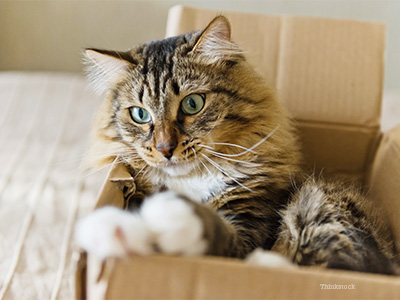
If you cohabitate with a cat, you’ve probably noticed the apparently addictive attraction felines foster for boxes. Minutes after I’ve emptied the contents of a cardboard container, one of our cats is sure to slink inside, defying all known theorems of geometry. The fact that cats are inexplicably drawn to climb inside boxes of all sizes and shapes is the plot of millions of online videos. Entertaining videos aside, veterinarians have begun to unwrap the mystery of why cats cherish cartons.
Why do cats like boxes: the predator drive?
The first thing you need to keep in mind when contemplating cats and cardboard is that felines are predators. The next thing you need to remember is my cats love to leap from boxes and grapple my lower limbs. Maybe this has happened so often I’m developing a phobia to boxes. Maybe you are, too. Regardless of my last therapy session, the feline predatory drive prefers places to prey from and hide in during rest. Bingo! A box!
Why do cats like boxes: keeping warm?
While that argument makes sense, it’s not as scientific as I’d like, and I like science. A cat’s normal body temperature is about 100°F to 102°F. Most homes are kept around 72°F. This temperature differential may offer another explanation of why cats like to curl up in small spaces — it’s warmer. My cats tend to cozy up against pillows, in-between chair cushions, and in any open container. My cat Itty Bitty Kitty’s favorite treat is a shoebox next to a window. Box full of bliss.
Why do cats like boxes: the angry kitty?
Another science-y conclusion for the “cat-in-the-box’” conundrum is the fact that maybe cats aren’t very good at forgiving. Anyone with a cat has observed them disappear for hours (or days) if they feel mistreated in any way. As in “I tried a new brand of litter” or “would you mind getting off that chair” type of mistreatment. Instead of talking through the conflict, cats are more apt to run off and hide – preferably in a box or similar container. Boxes are a “safe zone” that allow them to sleep, stew and eventually forget. Forgive? Never.
Why do cats like boxes: reducing stress?
Finally, hanging out in boxes may really reduce stress in cats. In the past I thought a cat’s cardboard contortions were akin to my anxiety-busting yoga stretches. While I still believe there may be something to that idea, research recently conducted on shelter cats, published in Applied Animal Behaviour Science, indicates hiding inside boxes helps reduce stressful behaviors and harmful hormone levels. The investigation also revealed having boxes around helped cats adapt faster and better to their new shelter environment. I’d encourage my fellow animal shelter advocates and volunteers to experiment with various boxes in your cat rooms and cages.
I admit veterinarians and scientists haven’t yet cracked the cat cardboard code. Cats are one of the most challenging subjects to scientifically study, and they’re horrible at completing questionnaires on time. Until we figure out feline mind reading, I’m afraid we’re left with our own best guesses at what motivates thousands of cats to fold themselves into all sorts of vessels (and attack my legs). They’re probably posting video of it on some secret feline website right now and laughing about it too—a lot.
If you have any questions or concerns, you should always visit or call your veterinarian -- they are your best resource to ensure the health and well-being of your pets.
